3 Approaches to Drone Program Management
How can one person or team account for all the factors that make a drone program successful? The folks at Skyward point out that fleets have options.
According to its downloadable Guide to Starting a Drone Program eBook, depending on a program's size and complexity, there are a few different ways to leverage internal and external assets to make the program a success.
Option one is to do it all yourself.
Believe it or not, some drone programs begin this way. One passionate person takes on full responsibility for every aspect of the drone program. From hiring pilots to budgeting to managing flights and ensuring data is collected well, this individual wills the program into existence and holds it together.
While this might work initially, it leads pretty quickly to a burnout. One person can't manage every aspect of a drone program, especially as the program grows beyond two or three people. And with no established processes in place, the program falls apart if the program leader moves to another role.
That's not to mention the issue of compliance. If every pilot needs approval from one person (or if you're the only pilot), accountability will be low. With no executive insight into how pilots are operating, you risk breaking regulations or company policies. This is the fastest way to get a program shut down.
The DIY approach isn't recommended, Skyward says. And it's not practical for any drone program larger than one to three people.
Option two is to use a variety of point solutions.
Almost every drone program goes through this phase at some point. You’ve realized that one person can’t do it, so you’ve distributed some responsibility to others in the program. To collaborate, you keep track of your operations in spreadsheets. You use a free airspace map to check airspace, and maybe a second app to plan your flights. You may even use a third app to capture the data or footage you need. Pilots in the field juggle these apps and use paper checklists for flight ops.
Results may be communicated just by word of mouth. And when it comes time to report to your executives, you have to scrape information together from all these different sources and port it into your company’s internal systems. This approach often works for a while, and it allows a drone program to get started inexpensively. But as your program starts to grow, its inefficiencies become more and more apparent.
Tools like spreadsheets fail to capture the scope of your operations, and there’s limited accountability for pilots in the field. And that’s not to mention the logistical nightmare of pulling together reports. To scale past this stage, your program needs a single system built for aviation operations. And maybe it could use a little bit of help from an expert consultant.
Option three, according to Skyward, is to partner with an expert vendor.
As a drone program manager, there are some things you just don’t have the time or resources to do: You probably don’t have the time to build your information systems from scratch. You can’t customize your business policies for aviation. And the idea of consolidating a long data trail into one system seems intimidating at best.
That’s why some software vendors offer solutions that are custom-built for managing drone programs. These solutions bring together functions like airspace intelligence, flight logs, personnel management, maintenance tracking, and program reporting. Some vendors also offer consulting services to help you overcome barriers, or even start your program from the ground up.
Program management solutions usually cost some money, but they can dramatically shorten the ramp time, simplify your workflow—and reduce a lot of headaches. Better, smoother operations mean you can focus on using drones to provide value to your company, versus just staying afloat. Best of all, they tend to be scalable, growing along with your program and providing continuity.
For any enterprise serious about large-scale drone operations, some kind of management system is a must.
Source: Skyward
